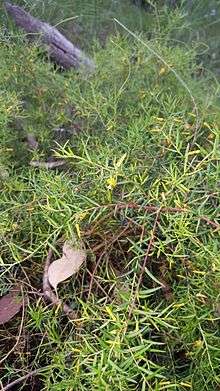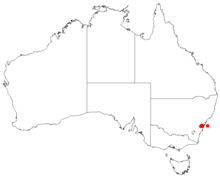Persoonia bargoensis
Persoonia bargoensis, commonly known as the Bargo geebung,[1] is a shrub native to New South Wales in eastern Australia.[2] It is currently classified under Commonwealth legislation as vulnerable, and is listed in New South Wales legislation as threatened.[1]
| Persoonia bargoensis | |
|---|---|
 | |
| Scientific classification | |
| Kingdom: | Plantae |
| Clade: | Tracheophytes |
| Clade: | Angiosperms |
| Clade: | Eudicots |
| Order: | Proteales |
| Family: | Proteaceae |
| Genus: | Persoonia |
| Species: | P. bargoensis |
| Binomial name | |
| Persoonia bargoensis P.H.Weston & L.A.S.Johnson | |
 | |
| Occurrence data from Australasian Virtual Herbarium | |
Lawrie Johnson and Peter Weston of the New South Wales Herbarium described the Bargo geebung as Persoonia bargoensis in 1991, having previously considered it an intermediate form between Persoonia nutans, which is found 40 km (25 mi) to the north, and P. oxycoccoides, which is found 25 km (16 mi) to the south. However further study found no evidence of intermediate forms between it and the other two species.[3]
Within the genus, it is classified in the Lanceolata group, a group of 58 closely related species with similar flowers but very different foliage. These species will often interbreed with each other where two members of the group occur.[4]
The Bargo geebung grows as a shrub with an upright habit, reaching 0.6 to 2.5 m high. The new growth is hairy. The leaves are alternately arranged along the stems.[3] The leaves are linear-lanceolate (spear-shaped) to lanceolate, and measure 0.8 to 2.4 cm long by 1 to 2.3 mm wide. Flowering takes place in December and January.[2] The flower heads are auxotelic, which means each stalk bears an individual flower that is subtended by a leaf at its junction with the stem.[3] There are 1 to 20 individual flowers in a flower head (rachis), which can be up to 25 cm long.[2] The flowers are followed by the development of the green drupes.[3]
The Bargo geebung is found in small scattered patches in an area bordered by Picton and Douglas Park to the north, Yanderra to the south, Cataract River to the east and Thirlmere to the west.[1] It grows on Hawkesbury Sandstone and Wianamatta Shale soils, 100–300 m (300–1,000 ft) above sea level.[2] It grows in dry sclerophyll eucalypt forest, under forest red gum (Eucalyptus tereticornis) and broad-leaved red ironbark (E. fibrosa) with a grassy understory of kangaroo grass (Themeda triandra), or more open woodland with such trees as red bloodwood (Corymbia gummifera), scribbly gum (Eucalyptus sclerophylla), grey gum (E. punctata), narrow-leaved stringybark (E. sparsifolia) and small-leaved apple (Angophora bakeri) with a shrubby understory of plants such as wreath bush-pea (Pultenaea tuberculata).[5] The increased light and lack of competing plants means the species adapts preferably to (and can be found on) road verges.[1]
References
- "Bargo Geebung - profile". Department of Environment and Conservation (NSW) Threatened Species website. Department of Environment and Conservation (NSW). 1 September 2005. Retrieved 9 November 2015.
- "Persoonia bargoensis P.H.Weston & L.A.S.Johnson". Flora of Australia Online. Department of the Environment and Heritage, Australian Government.
- Weston, Peter H.; Johnson, Lawrence Alexander Sydney (1991). "Taxonomic changes in Persoonia (Proteaceae) in New South Wales". Telopea. 4 (2): 369–406 [284].
- Weston, Peter H. (2003). "Proteaceae subfamily Persoonioideae: Botany of the Geebungs, Snottygobbles and their Relatives". Australian Plants. 22 (175): 62–78 [70]. ISSN 0005-0008.
- Benson, Doug; McDougall, Lyn (2000). "Ecology of Sydney Plant Species Part 7b: Dicotyledon families Proteaceae to Rubiaceae" (PDF). Cunninghamia. 6 (4): 1017–1202 [1097].
